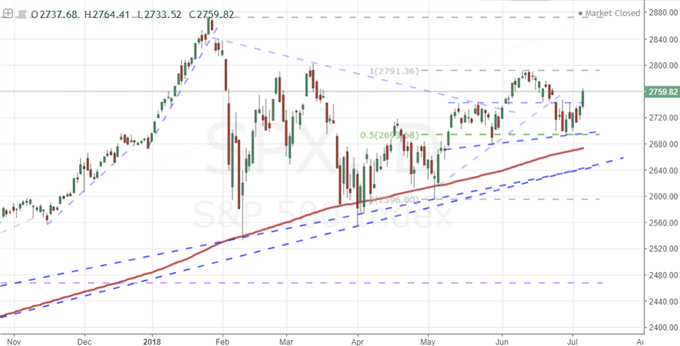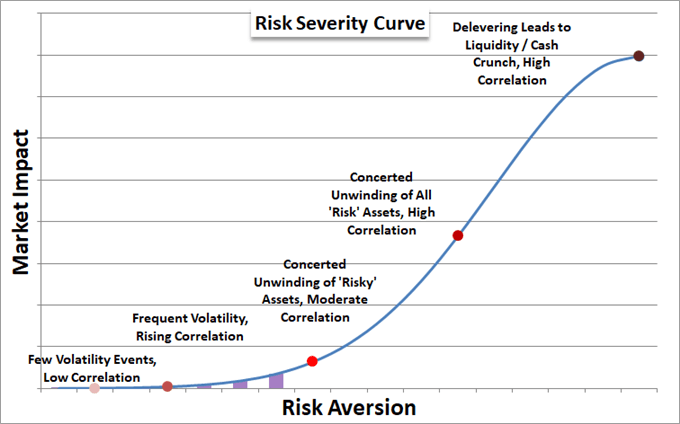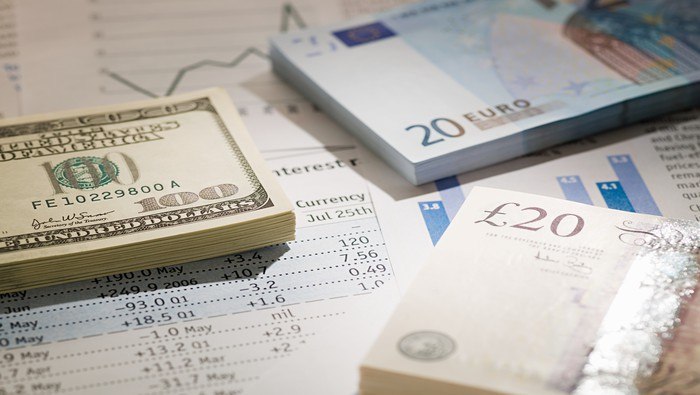Talking Points:
- Top headlines to end the week was the implementation of the US-China reciprocal ($34 bln) tariffs and June NFPs
- Despite the rubber hitting the road on trade wars, US equity indices buoyed sentiment - raising questions for sentiment
- Key event risk ahead are unscheduled updates on the trade war, the Fed's report to Congress, BoC rate decision and Brexit news
What do the DailyFX Analysts expect from the Dollar, Euro, Equities, Oil and more through the 3Q 2018? Download forecasts for these assets and more with technical and fundamental insight from the DailyFX Trading Guides page.
A Rebound In the S&P 500 and Dow Despite Trade War Action
Much of the trade war that has unfolded thus far has been threats or signal of intent for tariffs to be placed in the future (or triggered as retaliation upon the instigator's move). What the headlines signaled this past week was the definitive implementation of a very high burden on trade between the United States and China - the two largest economies in the world. As of midnight Friday, the US started to enforce $34 billion in tariffs against a list of Chinese goods in response to perceived long-term intellectual property theft. Occurring concurrently, China would also execute its own import taxes on US goods at the same scale. The subsequent $16 billion in duties that would round out the initial $50 billion threat are due sometime in the coming two weeks. This is definitively a step towards curbing global growth and the circulation of capital; and yet, the benchmark 'risk' assets climbed through Friday's end. The From a mixed view in the Asian and European sessions, the major US indices afforded a clear advance with the Dow winning a wedge break above 24,400 and the S&P 500 securing its best two-day rally in two months with a charge above 2,740.

The State of Risk and Influence of Trade Wars Ahead
If we were to simplistically extrapolate the market's performance through the end of the week, some may draw the conclusion that trade wars have been priced in and now do not matter or that sentiment is simply so robust it can concur all (a power so many song attribute to 'love'). Of course, that is an unreasonable assessment. Trade wars matter and they are progressing. Even if it doesn't spur a move to protect capital before the economic pain hits, the impact to actual growth is inevitable and detrimental. This is like ignoring smoke before the fire engulfs us. Exactly what has the capacity to revive our sensitivity to trade wars moving forward is unclear, but it probably isn't an ignorance that will be entertained for long. There are few scheduled events that can be directly tied to the next stage of the escalation. Threats or calls for reason between the United States and China are important events to watch for. However, for sheer global and sentiment impact, little will compare for risk to true progress in the auto tariff risks between the US and EU.

Dollar Has Multiple Temptations but No Conviction As Yet
While the US equity indices didn't render the expected response to the trade wars, the Dollar finally took a dive this past week as the risk of a collective retaliation started to enter the collective conscious. The trade-weighted DXY Index (heavily skewed towards the EURUSD) cleared recent support and is closing in on the 50-day moving average. Where this favorite benchmark is already marking progress, an equally-weighted index has leveled up to support without actually making the requisite technical break. The June NFPs this past Friday did little to shift focus to the economy or monetary policy, but next week's scheduled event risk can help urge the market's focus elsewhere. The consumer inflation data (CPI) and Fed's monetary policy report to Congress will put rate speculation to the test - for better or worse - while the University of Michigan consumer sentiment and NFIB small business sentiment surveys will gauge confidence amid policy changes.

Pound Will Double Down on Brexit, Loonie Counting Down to the BoC
Both the Pound and Canadian dollar were loaded for high level event risk to close out this past week. There was some significant development on both fundamental fronts, but rather little actual market movement. It may be reserving its response for the week ahead. While GBPUSD advanced on news that UK Prime Minister Theresa May won support for her 'soft Brexit' approach to the customs union internally, the real test is whether the EU is warm to their position. Brexit will remain top of mind for the Sterling; and until we have a clear view of its path, don't expect unfettered trends for GBPUSD, EURGBP and other GBP crosses. As for the Canadian dollar, the blend of employment and trade statistics offered a general improvement on the former and clear decline for the latter. Nevertheless, the Loonie made a limited move through Friday's close. The Bank of Canada (BoC) rate decision this coming Wednesday may offer a less complicated cue for the currency to follow. With USDCAD angling for a reversal, it is natural to find more speculative interest here, but AUDCAD and NZDCAD carry less contradictory baggage. We discuss all of this and more in this weekend Trading Video.

If you want to download my Manic-Crisis calendar, you can find the updated file here.







